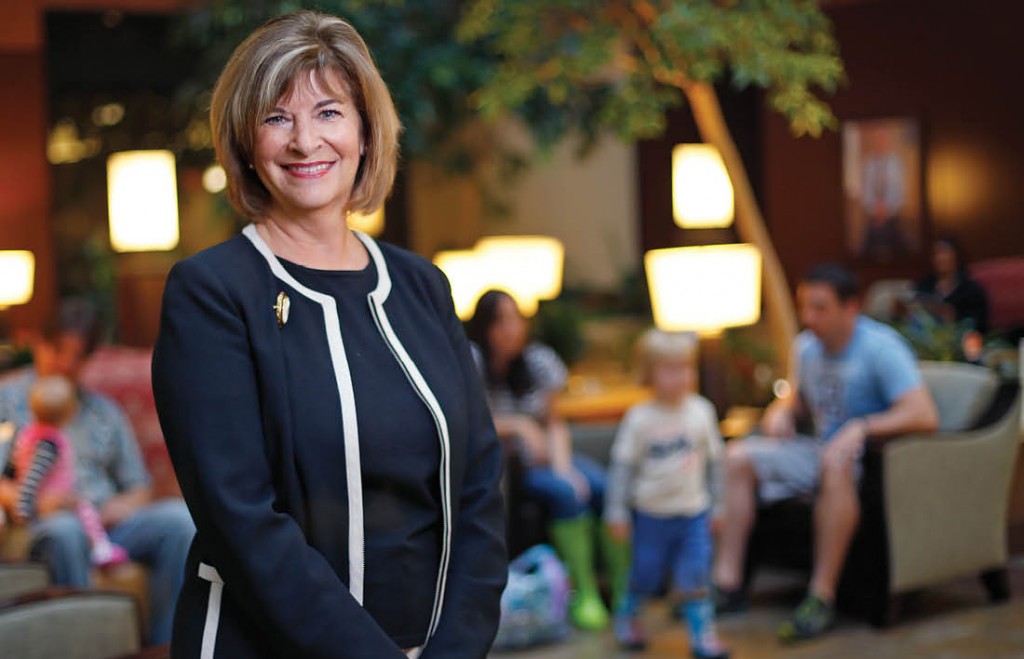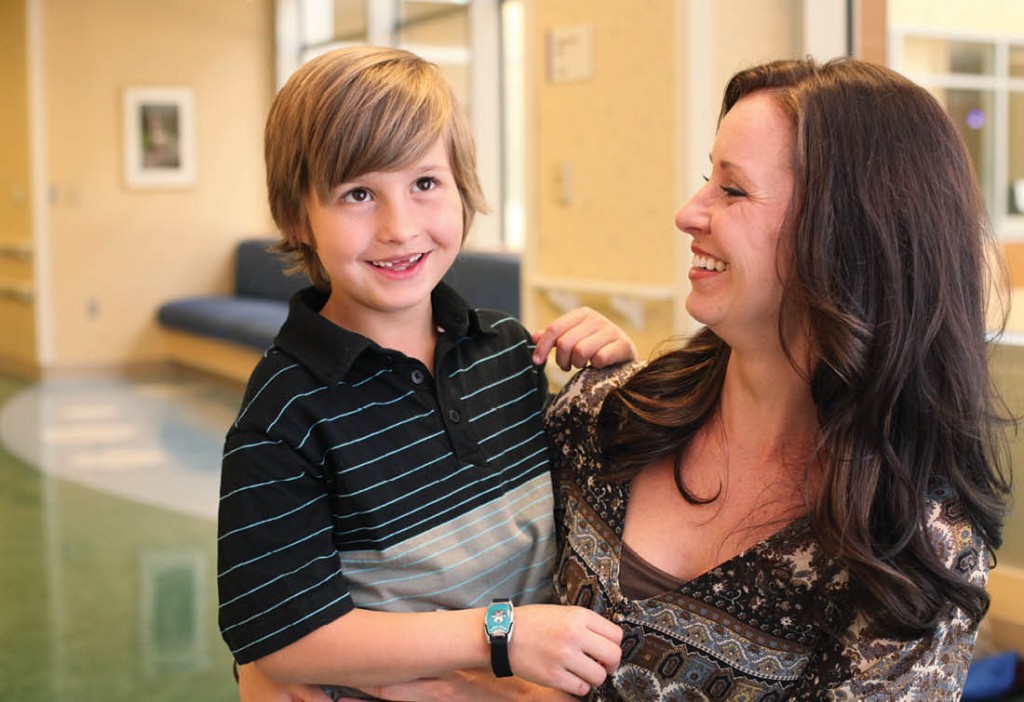If You Really Want to Improve Health Care, Start by Asking Those Who’ve Spent Sleepless Nights in Family Waiting Rooms
By Nancy Humphrey

During a recent clinic visit at Vanderbilt University Medical Center, Lynn Ferguson and two other patients were simultaneously called back from the waiting area for their procedures.
A clinic employee, holding all three patients’ charts, asked the three women together for their birthdates—month, date and year. An efficient clinic employee checking in more than one patient at a time? Not in the eyes of Ferguson, a member of Vanderbilt University Hospital’s Patient and Family Advisory Council, who shared her experience at the group’s July meeting.
One of the women clearly didn’t want to reveal her birth year in front of the other women, and she shouldn’t have been expected to, said Ferguson, suggesting instead they should have been asked individually, and privately, for the information.
“It’s definitely an opportunity for improvement,” Ferguson told the council, a polite way of saying that something needs to be fixed.
Ferguson and 18 other council members often act as “mystery shoppers” during their hospital and clinic visits, bringing both the good and the bad back to their meetings. The goal: Health care at Vanderbilt should be flawless, efficient and, most of all, patient- and family-centered.
The concept of patient- and family-centered care was first introduced to children’s hospitals nationwide in the early 1990s. It redefined relationships in health care, recognizing that the staff, patients and their families are partners on the health care team, working together to best meet the needs of the patient.
Vanderbilt embraced the concept about 15 years ago when the Vanderbilt Children’s Hospital Family Advisory Council was formed at what is now Monroe Carell Jr. Children’s Hospital at Vanderbilt. Since then VUMC has added patient and family advisory councils at Vanderbilt University Hospital and the Vanderbilt Psychiatric Hospital.
Patient and family engagement—an integral component of patient- and family-centered care—also has been embraced at Vanderbilt and, indeed, by the larger health care community. In fact, an editorial in the February 2013 issue of the journal Health Affairs called patient and family engagement “the blockbuster drug of the century … that should have formed the heart of health care all along.”
Terrell Smith, VUMC’s director of patient and family engagement, says the reasoning behind the need for family input in children’s hospitals is simple: “Parents of a 3-month-old obviously must be actively involved in the care because that child can’t speak for himself or herself. It’s intuitive in a children’s hospital that you acknowledge family members.”
During the design phase of the new freestanding Children’s Hospital that opened in 2003, a pediatric patient advisory group was formed because it was important to have both patient and family involvement in designing a hospital just for children.

“We asked them two questions: What does it look like when care is going well? And what does it look like when care is not going well?” Smith says. “Well, they can tell you,” she says, laughing. “They know.”
The children’s group comprises patients 8 and older, some with chronic illnesses that have required multiple admissions and who know the hospital well. “We were quite amazed and delighted that they came up with such wonderful observations because we were scared they would say they wanted a swimming pool in the lobby or a Ferris wheel somewhere,” Smith says. “Instead, we learned they see things from a whole different perspective.”
A Rock-Hard Dinner Roll
Smith recalls a young patient who spoke to the planning team about what he’d like to see in the new hospital. He came to the meeting carrying a dinner roll in a sandwich bag.
“I got served my lunch at 12 because they serve it at 12 whether I’m hungry or not,” he told the group. “They put the tray on my bedside table, but before I could take a bite, they took me for an X-ray. When I came back the food was cold, so my nurse put it in the microwave, but before I could eat it, they took me for another X-ray, and when I came back she put it in the microwave again,” he says.
“He pulled the roll, hard as a rock, out of a sandwich bag and started beating it on the table,” Smith says. The boy said he could call a pizza restaurant and have a piping hot pizza delivered from miles away in minutes. “Why can’t you people do that here and send it up two floors?” the child asked.
He had their attention long before he banged the petrified roll on the table, and the hospital planning team took action. From that encounter came room-service delivery of hot, fresh food within 45 minutes and kid-friendly menus that include pasta bars, pizza and sliders at mealtime and snacks like string cheese and fruit roll-ups.
An appealing menu isn’t the only improvement that representatives from the children’s focus group and the Children’s Hospital Family Advisory Council have been responsible for, says Janet Cross, MEd’86, director of patient- and family-centered care for Children’s Hospital.
When the new freestanding hospital opened, it included many ideas inspired by suggestions from both the children’s and family advisory councils: a movie theater; family quiet rooms, which are windowed areas of respite with no televisions or phones; and themed decorations—such as trees, wildlife, flowers and fish—that give each of the eight floors its own personality.
And when planning began for an expansion in 2010, the Children’s Hospital council members asked for and received a greater number of accessible electrical outlets, more comfortable sleeper couches, and more shelf and storage space. The family resting area also was repositioned and the television relocated to a central part of the room.
Gut Instincts
Nine-year-old Kael Adams of Mount Juliet, Tenn., is a frequent patient at Monroe Carell Jr. Children’s Hospital at Vanderbilt. Born in 2004 with Taussig-Bing anomaly, a rare and complex congenital heart defect, Kael has had 14 procedures, including open heart surgeries at 8 days and at 5 months, and will have more surgery next year. His health care team consists of cardiologists, nurses, staff members and his mom, Kara.

“It’s a partnership,” says Kara Adams, a three-year member and current chair of the Family Advisory Council at Children’s Hospital, acknowledging that the health care team’s acceptance of family involvement has evolved over time. “It hasn’t always been that way.”
Adams says parents should be included in the daily rounds of the health care team, listening, offering input and asking questions. “I know my son better than anybody. And sometimes that means the team should listen when my gut instincts are all I have to go on,” she says. “Kael’s cardiologist understands to take me seriously if I say something isn’t right. And I understand that his health care team won’t have all the answers all the time, but if we partner together we can find solutions.”
Bringing the Concept to the Adult Side
About seven years ago, a personal experience of Smith’s convinced her it was time to bring family-centered care to adult patients at Vanderbilt. Smith’s elderly mother fell and broke her hip, spent some time in the hospital, and then was readmitted during the night, critically ill with pneumonia. A resident physician, thinking she had been readmitted because of her hip, told Smith he’d order a hip X-ray.
“We didn’t know if she’d make it through the day,” says Smith, “so I told him an X-ray wasn’t needed and thanked him for stopping by. Two hours later they came to get her for the X-ray.”
Smith’s mother didn’t go.
“I thought, This is so interesting,” says Smith. “I thought I was speaking really clearly and was partnering with him, and he didn’t have that sense at all. He was a medical resident whose attending physician had told him to do something, and he was going to see it was done. And here I was in a hospital I know and love, full of all good people, and I realized we needed a philosophy that was different on the adult side.”
Patient and family engagement has been supported enthusiastically by the hospital’s leadership, Smith says, including Chief Nursing Officer Marilyn Dubree, MSN’76; David Posch, CEO of Vanderbilt Hospital and Clinics; and Gaye Smith, chief patient experience and service officer. “This couldn’t have happened without their support. It’s one of the secrets to our success.”
Don McSurley, whose wife, Judy, had a heart transplant and subsequent lung surgery at Vanderbilt, chairs the Family Advisory Council for Vanderbilt University Hospital. He was asked to be on the council after several years of clinic and hospital visits for his wife.
Soon after he joined, council members were asked to come up with a list of problems they had encountered during clinic and hospital visits. The group came up with 35 items, although McSurley admits it was difficult for him to say negative things about a medical center that had restored his wife’s health.
The list included a lighting problem, significant parking and signage issues, and inconsistencies in some of the clinics’ operations. The hospital’s CEO attended a meeting, reviewed the list, and a year later 34 of the 35 items had been corrected, says McSurley, a retired DuPont executive.
“With that kind of response, I couldn’t just walk away from the committee,” he says. “We can see things that others possibly can’t, or if they can, they feel like they can’t point them out. We’re a set of eyes, and they listen to us. Vanderbilt does an outstanding job of supporting its family councils.” VUMC is “exceptional” in making sure patients and their families are welcomed members of the health care team, according to a report by the Picker Institute, an organization dedicated to advancing patient-centered health care.
Members of Vanderbilt’s family advisory councils tell their stories at new-staff orientation sessions and faculty training. They sit on Medical Center committees like Food Services and Patient Education and speak to groups of medical students about their experiences. They are included as part of the health care team’s daily rounds. They ask questions and offer input.
It’s a mutually beneficial partnership. The adult hospital’s council has provided valuable input on how to make the Medical Center more family-friendly. Members have helped construct and finalize a patient guide given to each patient upon admission, were instrumental in seeing that VUMC became a smoke-free campus, provided feedback for “physician coaching,” and have helped fine-tune My Health at Vanderbilt, a secure online portal where patients can access their medical records and communicate with members of their health care teams.
“What makes our council so viable is that we’ve learned it’s OK to point out the negative and they solicit our input,” McSurley says. “We’ve been integrated into the Vanderbilt family.”
Nancy Humphrey is assistant director of Vanderbilt University Medical Center News and Communications. As the award-winning director of publications for VUMC, she supervises the editors of five Medical Center periodicals and serves as the department’s chief copy editor. With a master’s degree in journalism and history, she was once a general assignment and medical reporter for the Nashville Banner newspaper.